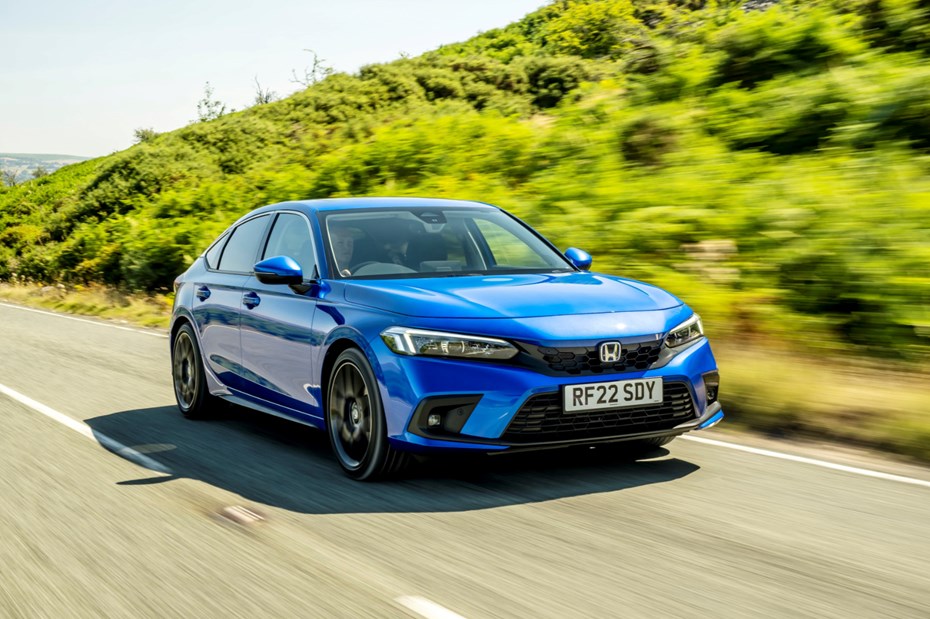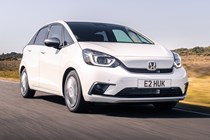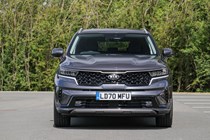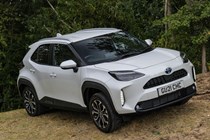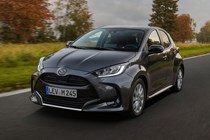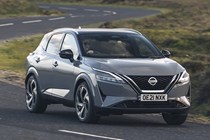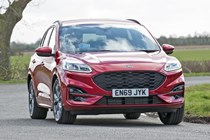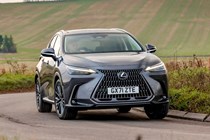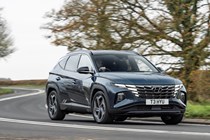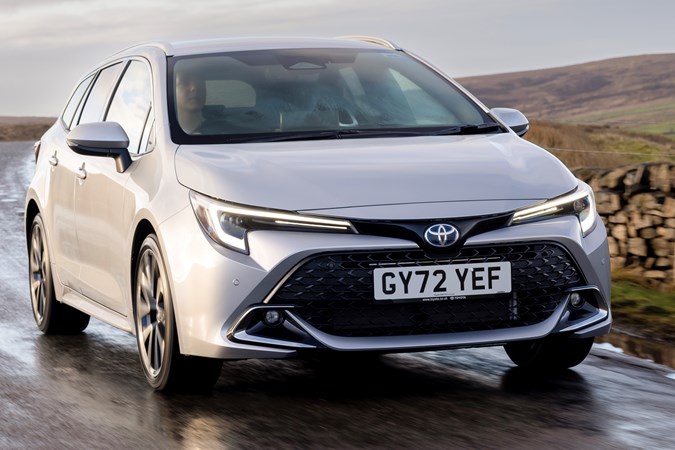Self-charging hybrid cars are a great interim solution for those who can’t make an electric car suit their lifestyle yet. They blend the convenience of a petrol car with the efficiency of a diesel – and they even drive for short distances on electric power alone, giving drivers a taste the EV lifestyle without the hassle of long charging times.
The term ‘self-charging hybrid’ was originally coined by Toyota to advertise its hybrid vehicles, but it’s become the easy way to differentiate these vehicles from mild hybrid cars and plug-in hybrid cars.
Technically speaking, all three of these systems can ‘self-charge.’ They can all generate their own electricity using their combustion engines or by harvesting the energy that would be wasted when decelerating, using the inertia of the vehicle to spin the electric motor and generate power. But self-charging hybrids have been optimised to work at their best using this method.
Self-charging hybrids are the middle ground in the hybrid technology tree. They offer a greater level of electrical assistance and bigger fuel economy gains than a mild hybrid system, but they can’t match plug-in hybrids for outright efficiency.
Most PHEVs can cover around 30 miles on electric power alone – and they make outrageous fuel economy claims of more than 100mpg. The catch? You won’t get anywhere close to those figures unless you’re prepared to charge them regularly at the mains.
If you can’t be bothered with the hassle of charging cables (or if you just want a simple way to spend less money on fuel and tread a little lighter on the planet), scroll down for our list of the best self-charging hybrid cars on sale.
The best self-charging hybrid cars of 2025
A former Parkers Car of the Year and a cracking family hatchback
Its hybrid system is very clever and very efficient – 60mpg is easily achievable around town. The car’s interior is also a model of common sense, good design and high quality. To top it off, there’s loads of space to play with, it’s well equipped for the money, it’s great to drive and it promises fastidious reliability. What more could you possibly want?
Read our full Honda Civic review
Pros
- Excellent fun to drive
- Punchy hybrid powertrain
- Efficient, especially in town
Cons
- Quite low-slung
- Small fuel tank
Nissan has refined the Qashqai formula into a very pleasant family SUV
It’s a very smooth and quite effective system, though prolonged high speeds can make the engine a little raucous as it struggles to replenish charge as quickly as you use it. The rest of the Qashqai is a perfectly serviceable – and actually quite premium – family SUV.
Read our full Nissan Qashqai review
Pros
- Smooth E-Power hybrid system
- Wide range of trim levels
- Spacious interior
Cons
- Infotainment trails rivals
- Noisy on the motorway
The reliability champ, now with better powertrains and a new touchscreen
The Corolla’s recent facelift gave it a much-improved touchscreen infotainment system that’s bright and clear, along with a little more power for its engines. We also like the car’s cabin. It’s a little cramped, but it’s very well put together and should stand up to the abuse of family life well. We reckon the Touring Sports estate is the model to go for, as it has slightly more space in the rear seats and a usefully larger boot.
Read our full Toyota Corolla Touring Sports review
Pros
- Both engines are pokey
- And they’re very efficient
- Massive 10-year warranty
Cons
- Cramped rear seats
- Hatchback has small boot
The most practical small car you can buy
The Jazz is exclusively available with a 1.5-litre hybrid powertrain that works in a similar fashion to the one in the Civic. It is a little less beefy, though – and that means it can sound quite strained when you’re thrashing, fully laden, up a steep hill. The Jazz is also a little expensive to buy, although that’s easier to stomach when you consider its interior space rivals cars in the class above.
Read our full Honda Jazz review
Pros
- Spacious, versatile interior
- Clear and solid dashboard
- Easy to drive with great visibility
Cons
- Expensive to buy
- Dull to drive
Large, premium seven-seat SUV works well as a hybrid
The Sorento’s self-charging hybrid system is great around town, but it struggles to disguise the car’s weight the faster you go. The petrol engine sounds a little coarse when you ask it to accelerate hard down a motorway slip road but, if you adopt a more moderate approach with the throttle, you’ll find it very easy to live with.
Read our full Kia Sorento review
Pros
- Spacious interior
- Seven-year warranty
- Comfortable ride
Cons
- Size cripples efficiency
- Third row is quite tight
All that's great about the Yaris in a more practical package
The interior might be a little dull to look at, but the Yaris Cross compensates in loads of other areas. It’s spacious, it has an impressively deep boot, it’s surprisingly fun to drive and it’s backed up by Toyota’s legendary reliability record and 10-year warranty. Plus, you can have it with four-wheel drive if you like.
Read our full Toyota Yaris Cross review
Pros
- Amazing mpg
- Peppy to drive
- Four-wheel drive available
Cons
- Dull interior
- Lacks sparkle
Your eyes don’t deceive you – this is basically a Yaris
Regardless of the brand you choose, you’ll end up with a neat and effective small car capable of a real-world 60mpg. Like the Yaris Cross above, the Mazda 2’s interior is a little dull and bland, but it’s well-built and reasonably equipped.
Read our full Toyota Yaris review (it's essentially the same car, anyway)
Pros
- The Yaris is a great starting point
- Genuinely small and easy to park
- Low running costs
Cons
- Bland interior
- Toyota warranty is better
Popular family SUV with excellent road manners
Thankfully, the Kuga is one of the best-handling SUVs money can buy, especially amongst its closest, non-premium brands. Plus, its 2.5-litre self-charging hybrid powertrain can rival diesel SUVs for fuel economy – and it has a very useful 190hp, so it’s no slouch.
Read our full Ford Kuga review
Pros
- Tight handling
- Powerful hybrid engine
- Spacious interior
Cons
- Cheap-feeling interior
- Boot could have been bigger
Lexus NX
Posh, premium and packed with Lexus’ hybrid know-how
In town driving it’s extremely efficient, and the large engine means that it’s also quite relaxed for motorway driving. You also a get a superbly premium interior, which feels built to last.
Read our full Lexus NX review
Pros
- Beautifully built interior
- Bound to be reliable
- Efficient
Cons
- Not the most fun to drive
- F-Sport seats are quite tight
Space-age SUV deals well with family life
Hyundai sells the Tucson with three flavours of hybrid powertrain. The self-charging system is smooth and pretty easy to drive. It’s not the most efficient hybrid system we’ve encountered, though. You’ll get better economy from a Ford Kuga.
Read our Hyundai Tucson review
Pros
- Practical, spacious interior
- Five-year warranty
- Straightforward tech
Cons
- There are more efficient hybrids
- Forgettable to drive
Self-charging hybrid cars FAQs
Is a self charging hybrid worth it?
Yes, if you consider them to be a replacement for a conventional petrol-powered car. It’s important to note that self-charging hybrids have much smaller batteries compared to plug-ins, meaning they can only run on electric power alone at low speeds and have a very limited zero-emission range (typically between 1 and two miles). Most of the time, the combustion engine and the electric motor are working in tandem to eke the maximum number of miles from a gallon of fuel.
If you’re using the car for urban driving (or you only tend to drive at low speeds), a self-charging hybrid makes a lot of sense. HEVs are at their most efficient around town, as they can recoup lots of energy with stop-and-go charging. But even if you tend to cover longer distances at higher speeds, you should see a marked reduction in your fuel costs, along with lower emissions (and therefore cheaper road tax).
Does a self charging hybrid save petrol?
Yes, although just how much you save depends on where and how you drive. A quick look at our list of the most economical cars on sale reveals that petrol hybrid and diesels are the best for saving fuel – just don’t think the technology can cure your high fuel bills if you have a lead foot. To get the best from the technology, you need to drive sensibly and allow the electric portion of the powertrain to recover as much energy as you can to improve the efficiency of the petrol engine.
The Toyota Yaris/Mazda 2 Hybrid (they’re the same mechanically, just with different badges) are currently the most economical new cars you can buy, with the Renault Clio E-Tech following closely behind. All three cars can top 65mpg in official test conditions – and we’ve managed to extract 60mpg from them in our real-world testing.
Are self charging hybrids good for long journeys?
They’re as good as any other car. Of course, the long-legged, low-revving diesel tops the lot for range and overall refinement, but a good hybrid such as the Honda Civic or Toyota Corolla take to motorways without any issues at all. The fuel-saving advantage of their hybrid systems are negated at constant high speeds (they always work best in towns), but they still score as well as their simpler petrol-only counterparts.
One thing we’ve found is that modern self-charging hybrids seem to have small fuel tanks (for packaging and weight reasons), which limits their cruising range. This is something to bear in mind if you’re a high-mileage driver.
What are the advantages of a self-charging hybrid?
Not all self-charging hybrid cars are alike, and they often have very different arrangements for putting power to the road. But in most cases, they offer a compelling stop-gap for buyers who’d like greater efficiency and lower running costs than a pure petrol or diesel car, but are unwilling or unable to graduate to a plug-in hybrid or a full EV.
Self-charging hybrids are usually cheaper than their plug-in siblings, and can be run effectively by those who don’t have off-street parking or access to a charger. They come in all sorts of shapes and body sizes, from superminis to SUVs, and in comparatively cheaper cars right up to very premium options.
Luke Wilkinson is Deputy Editor of Parkers. He spends his time writing news, reviews and features for the site, in addition to contributing words to our sister publication, CAR magazine. He’s worked as a car journalist for five years, having started his career as a Staff Writer at Auto Express in November 2018.
Just so you know, we may receive a commission or other compensation from the links on this website - read why you should trust us.


